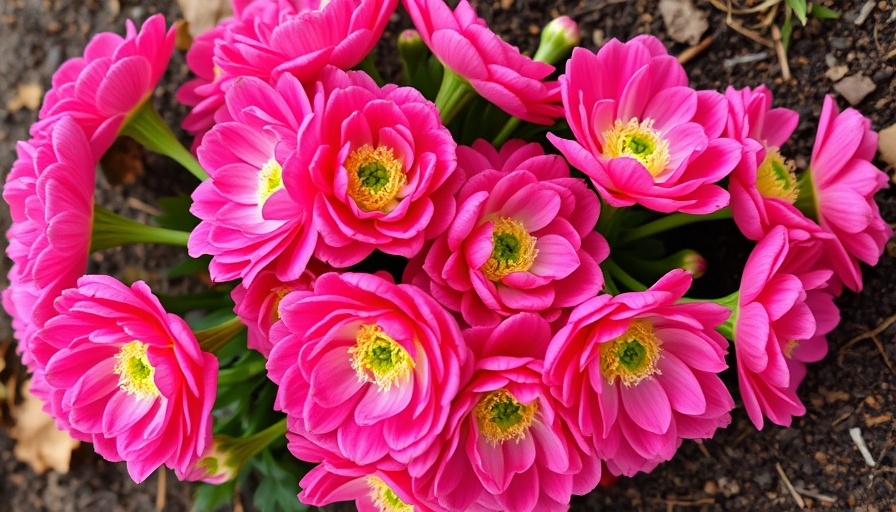
Spring Awaits: Why Ranunculus is a Must-Have Cut Flower
After the last frost, as spring breathes life back into our gardens, ranunculus flowers emerge as one of nature's exquisite gifts. With a visual allure reminiscent of peonies and roses, these blooms are some of the most sought-after cut flowers for floral arrangements—especially for weddings and special occasions. Understanding how to properly grow ranunculus can transform your garden into a blooming spectacle, ensuring that these lovely flowers beds are not just a fleeting beauty.
In this article, we’ll discuss essential gardening tips for growing ranunculus, including pre-sprouting techniques, planting advice, and best practices for harvesting these enchanting flowers for your bouquets.
Pre-Sprouting: An Essential Step for Success
Every successful gardening journey begins with preparation. For ranunculus, the first step is ensuring that the corms—often resembling shriveled calamari—are revitalized before planting. Soaking corms in water for 3-4 hours helps them rehydrate, making them more viable for growth. Post-soaking, you have two choices: you can plant them directly into your garden or go for the extra step of pre-sprouting in a seed tray.
Pre-sprouting offers numerous benefits. By nurturing the corms indoors in a controlled environment, you mitigate risks such as transplant shock and temperature fluctuations. This technique enables your ranunculus to bloom slightly sooner, making it a worthwhile investment for any gardener seeking abundant blooms.
Timing: The Right Moment for Planting
Timing is crucial in gardening, and ranunculus is no exception. Depending on your climate zone, you may choose to plant either in the fall or in late winter/early spring. For those in milder zones (generally zone 7 and above), planting in the fall can yield lovely results, albeit with precautionary measures against colder temperatures.
The rule of thumb suggests that once the corms are soaked, they take about 90 days to transition into blooming flowers. To maximize your blooms, plan your planting date backward based on your expected bloom time—think of it as creating a blooming schedule tailor-made for your garden!
Care and Maintenance: Nurturing Your Ranunculus
To grow robust ranunculus flowers, proper care is essential. These beauties prefer well-drained soil enriched with organic materials. Monitoring soil moisture is crucial; they need consistent watering but are sensitive to over-saturation. As spring unfolds, ensure that your garden provides adequate sunlight without letting harsh midday rays scorch the tender foliage.
To further enhance the growth of your ranunculus, consider implementing a regular fertilization regime using organic pesticides or fungicides as needed. With thoughtful care, your ranunculus flowers can thrive, providing a bounty of stunning blooms.
Harvesting for Maximum Bloom Time
Once your ranunculus flowers reach a vibrant maturity, harvesting should be done with care to ensure maximum longevity. The best time to harvest is just after the blooms have opened partially. Cut the stems at an angle to allow for better hydration once they reach the vase. Always remember to keep your cut stems in a cool place until arranged to ensure freshness.
Saving and Storing Corms for Future Seasons
Once your blooms have faded, don’t discard your corms! With proper care, you can store them for the next growing season. After allowing the corms to dry out completely, store them in a cool, dry, and dark location. This simple practice not only conserves the beauty of your previous blooms but promotes a sustainable gardening practice.
Conclusion: Cultivating Beauty and Community
Growing ranunculus transcends beyond mere gardening; it fosters community, contributes to local biodiversity, and enriches our surroundings with beauty and fragrance. Each bloom tells a story of hard work and passion, and as you begin—or continue—your own gardening journey, let the spirit of ranunculus serve as a reminder of what can emerge from even the smallest seed of effort.
As you venture into growing ranunculus or any other blossoms this spring, remember that every plant nurtured is a step toward connecting with nature and your community. Embrace this gardening season with enthusiasm, and let your flower garden bloom brilliantly.
 Add Row
Add Row  Add
Add 




Write A Comment